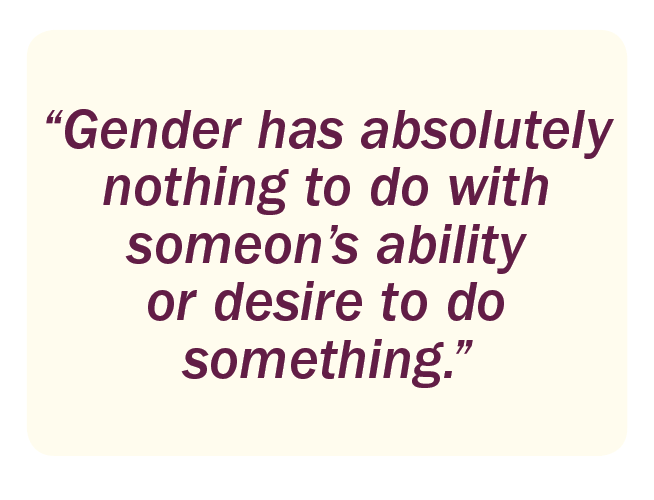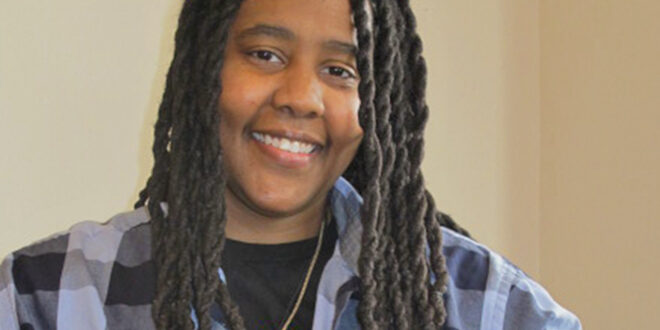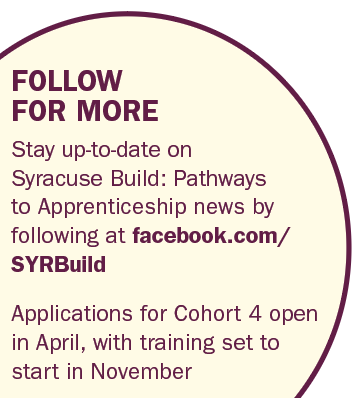Trades Teacher: Ebony Farrow
By Ashley Kang
Advocacy, says Ebony Farrow, is how she got into workforce development. “I’ve been an advocate for as long as I think I could talk,” she says with a laugh. “With the Pathways to Apprenticeship program, I wanted to make sure Syracuse residents had an opportunity to access jobs paying livable wages.”
The 11-week, pre-apprenticeship program under the city’s Syracuse Build initiative helps prepare residents to move on to careers in the construction field. The exposure to different unions and the wide variety of job options, she says, is an important feature of the program, ensuring participants know what to expect in their next steps.
As the program manager, she’s combined her knowledge of construction, workforce development and social justice to design a program that addresses potential barriers to entry and offers support not only during the training but even after students graduate.
She finds no two work days are the same and is drawn to the hands-on nature of the program. “I have a joy for teaching, sharing knowledge I’ve gained and passing it down,” she says. “But I also get a lot of joy out of learning from those I share the classroom with.”
Q. How does your prior experience make you the best fit for this role?
A. I’ve worked in workforce development for 10-plus years, and I’ve done residential construction, doing side jobs for almost as long. I’ve noticed a topic that surfaced in all of my classrooms was the ability to have sustainable income. Generally, the qualifications to gain access will often knock somebody right out the box before getting an opportunity to get in the door. So in helping to design Pathways, I wanted to make sure it wasn’t setting up barriers for people to get into the program.
Q. What are your top priorities in leading this program?
A. At the top of my list is ensuring each student understands that they’re fully supported and backed by us and by every agency that works with us. I want them to know they are not doing it by themselves. The program offers a micro version of what will happen when they join a union. It’s intense. I want them to understand this is one step of many in preparation for the next 20 to 25 years of their life. I want to see them develop the skills that will help them succeed once they leave Pathways and move on to an apprenticeship.
Another priority is evaluating how we designed the program and how we continue to develop it by keeping in mind ways to support our most vulnerable populations. In doing that, anyone who enters the program will have the adequate services they need. If we’re designing around the most vulnerable and someone only needs a couple of services, those services will already be included. Universal design is key for the program’s integrity and longevity.
Q. Is additional support offered to cohort trainees? For example, it’s a paid training, but what about help with childcare? Transportation? Necessary supplies?
A. We provide basic tools — measuring tape, speed square, hammer, hi-vis vests, hardhat, safety goggles — and then when they graduate, we give them steel toed boots.
In terms of other support, we’re connected with P.E.A.C.E. to help people with child care services. And the Syracuse Financial Empowerment Center comes in to teach financial literacy. Transportation assistance is on a case-by-case basis. We understand how essential having a vehicle is for construction. We’ve provided Uber gift cards and are in the process of developing a pilot program to further assist with transportation.

Q. How do you motivate students?
A. I try to be creative. Often people don’t understand their knack for taking things apart or for putting things together correlates directly to construction. These are the people that will be drawn to this work and are often hands-on learners. So I plan hands-on activities. One example, I made a competition out of the blueprint reading. Now those who are naturally competitive take to it. They don’t understand that the learning that’s happening is innate. They are trying to win, but here’s the thing, they still gain the knowledge.
Q. As a Black woman, what challenges have you faced?
A. I’ve faced the typical ignorance around my knowledge base, (questioning of) the reason I’m sitting in the room to having my opinions or presence ignored. But more often than not, I’m faced with people attempting to use my expertise, when they can no longer ignore it, against me, in the form of calling me aggressive or threatening because I dare to know what I’m talking about.

I’m not willing to be quiet in a room full of big egos or (perspectives) that this is how it has always been done. I think much of time, the reason something is not working is because it never did; it was just in place because somebody put it there and didn’t have the courage to change it. Now, previous ways of thinking are being challenged and also being changed. I think that my experience in life, growing up in Syracuse and having friends and family members who have been locked out of places that they should have not just been granted access to but been in charge of, has taught me a lot about what barriers are in people’s way. I’m not talking about the people trying to get in, I’m talking about the people who are sitting at the gateway of those opportunities. Often they haven’t been cultured to anything other than that type of business culture.
During the pandemic and with George Floyd, as tragic as it was, both granted people a different type of understanding. I think that shined a different light and allowed folks to really see how people of color have been systematically locked out of places … to see how some people were never afforded that step in the door, to even get an opportunity.
Q. What are some of the barriers you still see?
A. One common denominator is mindset. One example, if a woman is seen, it becomes a question: ‘Is she supposed to be on this site? Can she do the work?’ Gender has absolutely nothing to do with someone’s ability or desire to do something.
I think that people are coming around to a better understanding that that mindset is ineffective and not very productive. And there are unions who not only accept women, but advocate for women to be in the union. I’ve even heard it said that women are more detail oriented and get the job done better when it comes to craftsmanship than a lot of their male counterparts.



Q. What is something in this field that people are surprised to learn?
A. For those not used to cycle work, understanding that weather plays a major part, and understanding that the building they’re building is not built yet. So, when it’s cold outside, it’s just as cold inside the structure. The structure may have a roof and a floor, but it has no walls. It can even become a wind tunnel, making it colder inside where you’re working. Same thing with the heat. If you’re working on a roof and the tar is reflecting the sun directly into your face over a long period of time, you have to make sure you’re hydrated. The weather plays a major part in how effective you will be to sustain your work over the duration of your shift.
Additionally, political events play a factor, too. During the pandemic, the price of lumber skyrocketed. So there are times when even incidents that are not local but happening globally will affect material prices, even the supply chain and ability to get materials. So politics can affect construction, just like it affects everything else.
Q. What is your top goal for Pathways?
A. To see students from our early cohorts continue to advance. To move up into supervisory positions, instructor positions, to be involved in the union interview process, be in administrative positions. This way they’re able to affect the entire community once they’re inside the union. I want to see them circle back by returning to teach part of the training.
Ashley Kang is director of The Stand
 The Stand
The Stand



